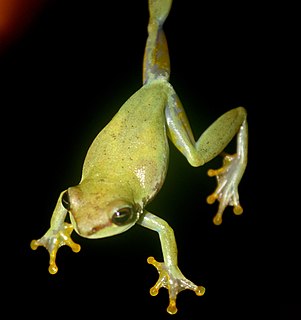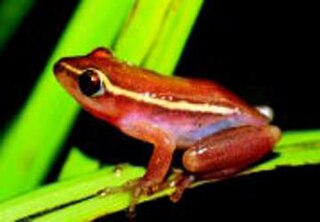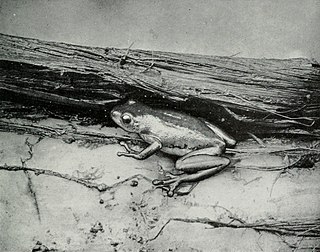
Hyperolius acutirostris is a species of frog in the family Hyperoliidae. It is endemic to southwestern Cameroon, found as far east as the region of Yaoundé. Common name sharpsnout reed frog has been coined for it.
Hyperolius balfouri is a species of frog in the family Hyperoliidae. It is found in Cameroon, Central African Republic, northeastern Democratic Republic of the Congo, South Sudan, southwestern Ethiopia, Uganda, and western Kenya. The specific name balfouri honours J.W. Balfour, a missionary in Uganda. Common names Balfour's reed frog and Ethiopia reed frog have been coined for this species, with the latter name referring to the now-synonymized Hyperolius zavattarii. Populations from the western part of the range may be referred to the subspecies Hyperolius balfouri viridistriatus.
Hyperolius baumanni is a species of frog in the family Hyperoliidae. It is known from the Akwapim-Togo Ranges along the border between Ghana and Togo and from central Ghana. Common name Baumann's reed frog has been coined for this species.
Hyperolius bolifambae is a species of frog in the family Hyperoliidae. It is known from southeastern Nigeria, southern Cameroon, and southwestern Central African Republic, with an isolated record in northeastern Democratic Republic of the Congo ; the latter record may be considered doubtful. It likely has a broader range towards south and east than currently documented, and the AmphibiaWeb includes Gabon and the Republic of the Congo in the distribution.

Hyperolius castaneus is a species of frogs in the family Hyperoliidae. It is found in the highlands of western Burundi, Rwanda, and Uganda as well as eastern Democratic Republic of the Congo. Common names of this species include Ahl's reed frog, brown reed frog, and montane reed frog. The status of the putative subspecies Hyperolius castaneus rhodogaster is unclear, and it may actually be a distinct species. Also Hyperolius constellatus, now a distinct species, was formerly recognized as a subspecies of H. castaneus.

Hyperolius concolor, also known as the variable reed frog or Hallowell's sedge frog, is a species of frog in the family Hyperoliidae. It occurs in West and Middle Africa.
Hyperolius dintelmanni is a species of frogs in the family Hyperoliidae. It is endemic to Cameroon and found in the montane southwestern part of the country. Specifically, it has been recorded from the Bakossi Mountains, including the Edib Hills and Mount Kupe. The specific name, dintelmanni, honors Mr. Horst Dintelmann from Germany in recognition of "his support of taxonomic research and forthcoming conservation projects in Cameroon".
Hyperolius discodactylus is a species of frogs in the family Hyperoliidae. It occurs in the montane areas of eastern Democratic Republic of the Congo and western Uganda, Rwanda, and Burundi. It is also known as the Albertine Rift reed frog, highland reed frog, or disc-fingered reed frog.

Hyperolius fusciventris is a species of frog in the family Hyperoliidae. It occurs in West and Middle Africa between Sierra Leone in the west and western Cameroon in the east. Common name lime reed frog has been coined for this species.

Hyperolius kihangensis, also known as the Kihanga reed frog or volcano reed frog, is a species of frogs in the family Hyperoliidae. It is endemic to the Udzungwa Mountains in south-central Tanzania.

Hyperolius mitchelli is a species of frogs in the family Hyperoliidae. It is found in the area between northeastern Tanzania, Malawi, and central Mozambique.
Hyperolius occidentalis is a species of frog in the family Hyperoliidae. Its common name is western reed frog. It is found in the coastal lowlands of westernmost West Africa in Senegal, the Gambia, Guinea-Bissau, Guinea, and Sierra Leone.

Pickersgill's reed frog is a species of frog in the family Hyperoliidae. It is endemic to South Africa. It occurs in the coastal lowlands of KwaZulu-Natal between Sezela and St Lucia.

Hyperolius picturatus is a species of frog in the family Hyperoliidae. It is found in northern and eastern Sierra Leone, southern Guinea, Liberia, Ivory Coast, and Ghana; its range might extend to Togo. Common names coined for this species are Tanzania reed frog and variable montane sedge frog.
Hyperolius pseudargus, also known as the Mette's reed frog, is a species of frogs in the family Hyperoliidae. It is endemic to south-central Tanzania and occurs in the Udzungwa Mountains and south to Njombe in the Southern Highlands. Male Hyperolius pseudargus greatly resemble Hyperolius argus but have less webbing between the toes and the male advertisement call is different. The vernacular name refers to Mette Westergaard, Danish biologist who collected the holotype and is the junior describer of this species.
Hyperolius sankuruensis, also known as the Omaniundu reed frog, is a species of frog in the family Hyperoliidae. It is endemic to the Democratic Republic of the Congo and is known from its type locality, Omaniundu in the Sankuru Province, and from a number of unspecified other localities. It is one of the "lost" frogs that was rediscovered decades after the last previous sighting.
Hyperolius sheldricki is a species of small frog in the family Hyperoliidae. It is endemic to southeast Kenya. The type locality is in the Tsavo East National Park.

Hyperolius spinigularis is a species of frog in the family Hyperoliidae. It is found in the Mulanje Massif in southern Malawi and the Namuli Massif in adjacent Mozambique. Records from Tanzania refers to other species. Males of this species have characteristic small spines during the breeding season. Its common names are spiny-throated reed frog, spiny reed frog, and Mulanje reed frog.
Hyperolius sylvaticus is a species of frog in the family Hyperoliidae. It is found in southern Ivory Coast, Ghana, Togo, Nigeria, and western Cameroon, with a gap in Benin. It is also likely to occur in Liberia. Common name Bobiri reed frog has been coined for this species.

The reptiles and frogs of the Eastern Highlands of Zimbabwe and Mozambique mark a biodiversity hotspot for herpetofauna. Diverse frog and reptile communities include endemic species.











